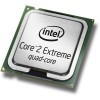- Qualcomm Launches Snapdragon 4 Gen 2 Mobile Platform
- AMD Launches Ryzen PRO 7000 Series Mobile & Desktop Platform
- Intel Launches Sleek Single-Slot Arc Pro A60 Workstation Graphics Card
- NVIDIA Announces Latest Ada Lovelace Additions: GeForce RTX 4060 Ti & RTX 4060
- Maxon Redshift With AMD Radeon GPU Rendering Support Now Available
Intel Core 2 Extreme QX6850 Quad-Core

Intel today is announcing their 1333FSB Core 2 line-up, which consists of three dual-cores, including the E6750 we previewed a few weeks ago, and also the 3.0GHz quad-core that we are testing out today. Read on as we explore all of what Intel’s latest flagship processor has to offer.
Page 5 – Workstation Benches
One crowd that benefits from faster processors and additional cores is the workstation crowd, those who render huge models that can take hours to complete. 3D Studio Max has been multithreaded for quite a while, even back in the day when some workstations had two physical CPUs installed, with one core each.
This is one real-world scenario where a Quad-Core processor can actually increase the rendering time upwards of 3.8x, so the benefits of owning such a chip is undeniable. For our test, we render an object with 406 objects and 106,000 vertices to a 3200×2400 resolution.

The results here are good. Comparing our E6600 to the Q6600, we see a 94% increase in rendering time. Then moving from a 2.4GHz Quad-Core to our QX6850, there is yet another 20% increase. These types of speeds almost make me wish I was a model designer myself. The benefits seen here would be crucial to any business that relies on rendering large projects.
Like 3D Studio Max, Cinebench emulates a similar scenario, where you render a high-resolution image. The nice thing about Cinebench though, is that it spits out a nice, clean number and also shows you your gain when moving to multi-threaded rendering.

Once again we can see the immense benefits of the larger processor, even in the single-thread mode. The 3.0GHz clock speed will prove useful in more than one scenario.
POV-Ray is another program with the sole purpose of creating amazing scenes and models. Similar to Cinebench, POV-Ray includes a multithreaded benchmark that will render a large model and output a score of PPS, or pixels per second.

Again, the QX6850 majorly outperforms even the Q6600, but it’s not unexpected. I think we’ve clearly shown that for any type of rendering project, quad-core processors are a serious blessing.
Support our efforts! With ad revenue at an all-time low for written websites, we're relying more than ever on reader support to help us continue putting so much effort into this type of content. You can support us by becoming a Patron, or by using our Amazon shopping affiliate links listed through our articles. Thanks for your support!





